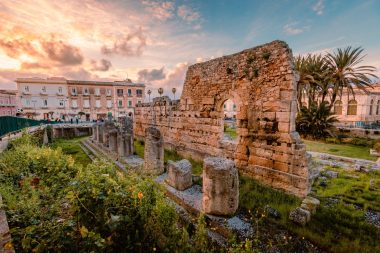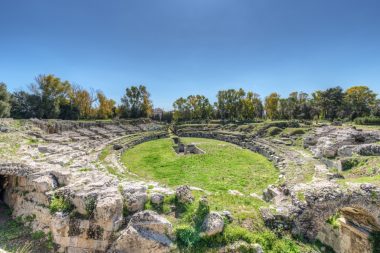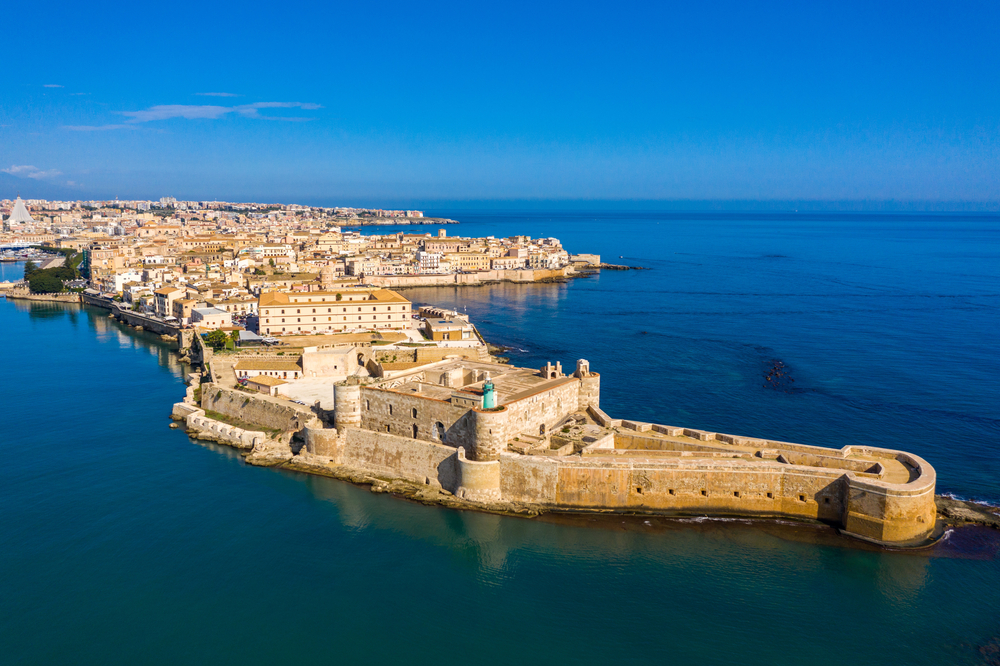Sicily – this island is without a doubt one of the most beautiful sides of Italy. It is embraced by a sometimes gentle and sometimes wild sea and blessed with an almost permanently serene sky. If you stroll through the ancient city of Syracuse in Sicily with your eyes open, you will embark on a journey into the past and thus into the varied history of this region. Before Syracuse became what it is today, Romans and Greeks were here. The holidaymaker follows in the footsteps of this era during a stay in this cheerful yet melancholic city.
The hometown of the genius Archimedes
Syracuse is also associated with the name of a historical figure. With that of the brilliant mathematician, designer and physicist Archimedes. Even though much of the Greek’s life remained hidden behind a veil, this man became a legend. Not least because he rendered outstanding services to Syracuse in the Second Punic War between the forces of Rome and Carthage by developing completely new throwing machines for his Sicilian hometown during the siege. Several centuries later, Syracuse replaced Constantinople as the capital of the Eastern Roman Empire, albeit only for a short time. This metropolis in the deep European south can look back on a rich history. And she is proud of the testimonies of past eras.
The statue of the Apostle Paul
The first traces of Syracuse have been found on the Ortygia peninsula. Here there was an abundant freshwater spring not far from the meandering rivers Ciana and Anapo, the Fonte Aretusa, which still bubbles today. The city was founded during the reign of the tyrant Dionysius, but the terrain of the so-called “quail island” Ortygia soon became too small to accommodate almost five hundred thousand people. But the ancient core of Syracuse is located in Ortygia, with the winding streets of a charming old town. Between the ruins of the Temple of Apollo and the historic harbor, there is haggling as always over the price of the fish caught. On the site of the former temple veneration for the deity Athena, a Christian church now rises on the cathedral square. Many devout Sicilians are convinced that the apostle Paul landed in Syracuse on his way to Rome . A statue has been dedicated to him in front of the cathedral.
The Old Town in the UNESCO List

When Syracuse was almost completely destroyed by a devastating earthquake in 1693, the city was rebuilt in the Baroque style. Santa Maria delle Colonne, the main church of the city, was created as an amazing architectural mixture of different elements. Here you will find a mixture of temples of antiquity as well as Norman architectural styles and the perfect devotion to the Baroque. Inside the cathedral, the beautiful mosaic work and the four-metre-high silver statue of Saint Lucia are remarkable. The wooden roof from the 16th century has been preserved. In the evening hours, the Piazza del Duomo in the old town develops a very unusual flair and could serve as a cinematic backdrop with its palazzi. It was probably the collection of testimonies of different cultures that prompted UNESCO to include the entire historic center of Syracuse in the list of World Heritage Sites.
The famous “Ear of Dionysius”
Visitors to the city are often overwhelmed by the power and grandeur of Syracuse. After all, this metropolis was a kind of cosmopolitan city on the Mediterranean for a long time. At the latest when visiting the archaeological park Neapolis, the guest gets an impression of the former dimensions. In addition to the huge amphitheater with its once 15,000 seats, the so-called “Ear of Dionysius” is a visitor magnet in the park. This is a cave in the limestone. The entrance to this 65-metre-deep grotto actually resembles a human ear and has always been the birthplace of various legends. The cave is part of the “Latomia del Paradiso”, a quarry where material was extracted for the construction of the ancient city. Friedrich Schiller was inspired by the “Ear of Dionysius” to write his ballad “Die Bürgschaft”.
Refuge of the early Christians

This city by the sea breathes history with its archaeological sites, but also with its museums worth seeing. The city dedicates the Museo Arkimedeion to Archimedes, the most famous son of Syracuse. The mathematician’s discoveries are the focus here, and because all this has been prepared in an understandable way, a visit to this house is also recommended for young people. In the ancient area called “Tyche”, the path of the visitors leads into the underworld. Not far from Viale Teocrito, the famous catacombs of Syracuse were built. They were once the refuge of the early Christians, who had to hide from the Roman soldiers. However, the fact that the apostle Paul visited this site could be part of the legend. The fact is that in these catacombs the Christians laid their dead to rest. The Basilica of San Martino is one of the oldest places of worship in Syracuse. It dates back to the 6th century BC and is located opposite Palazzo Bellomo. And if you have studied the ancient sites on the Ortigia peninsula, you should definitely visit the Castello Maniace. It was the Byzantines who started building this house as early as the 11th century. However, the Castello was not completed until the reign of Frederick II.


